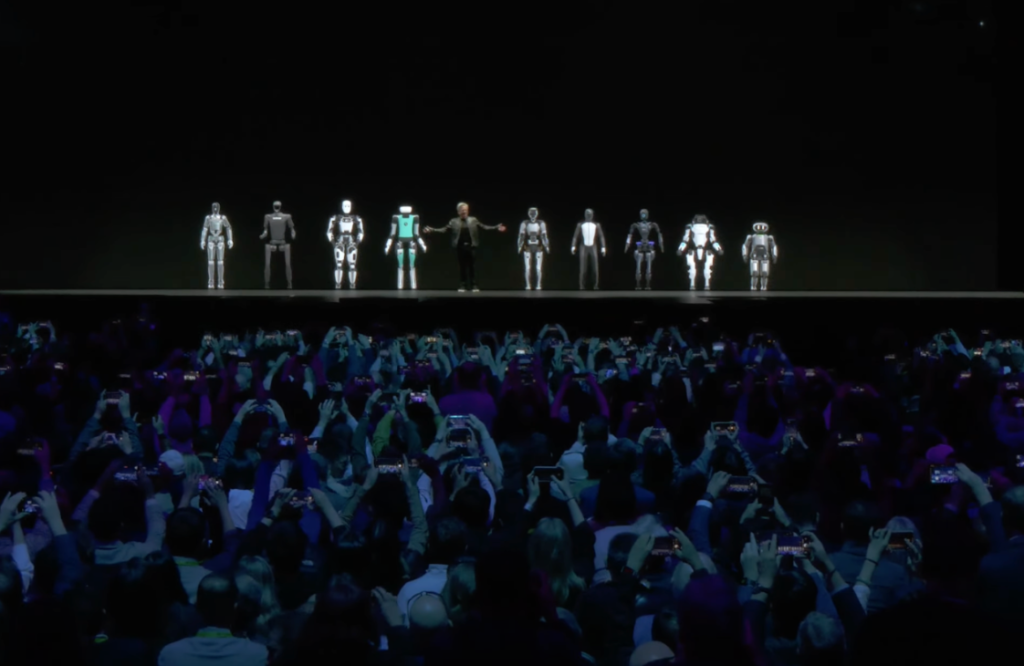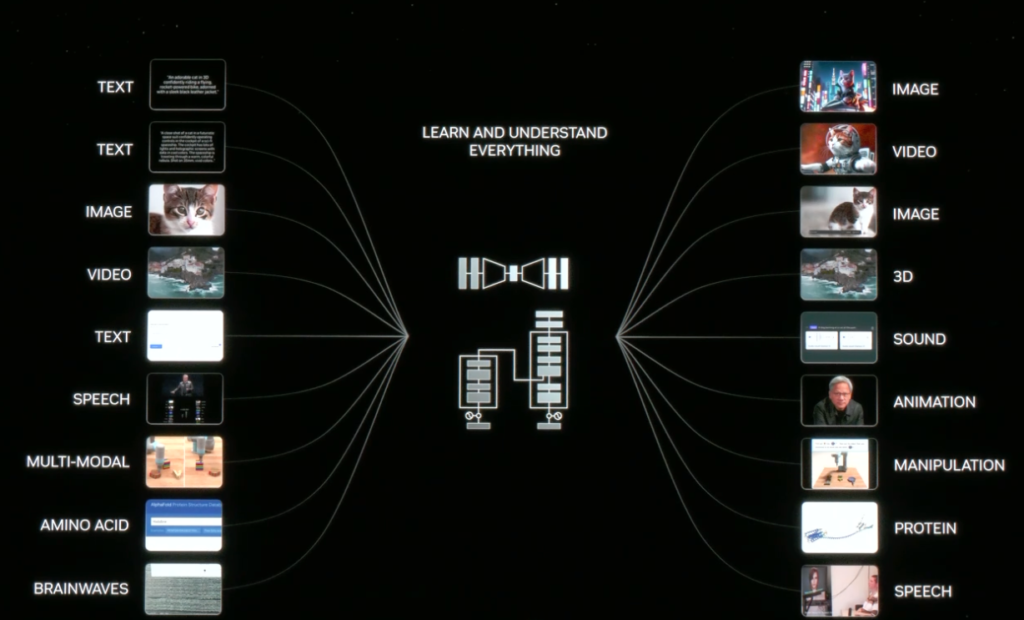Artificial intelligence, creativity and a very restless 100 trillion dollars

Check out the highlights of GTC 2024, Nvidia’s global conference, in a series of three exclusive pieces of content that our CEO, Pedro Braga, has developed for our customers and collaborators.
Nvidia’s GTC used to be a developers’ conference. It used to be, because the 2024 edition has become the biggest event San Francisco (CA) has seen in recent years, with dramatic and pyrotechnic launches that promise to further expand the horizons, possibilities and applications of Artificial Intelligence.
Over the last few days, we’ve closely followed everything we can understand about one of the major players in this revolution, which has shaken up the technology market and impacts on practically every industry.

Opening keynote with Jensen Huang, CEO at Nvidia: Artificial intelligence and the 100+ trillion-dollar revolution
100T USD is the estimated size of the technology market in a few months. Obviously, this will be the market most impacted by the Artificial Intelligence revolution, but Jensen Huang, CEO at Nvidia, made it clear in his opening speech that we are facing a revolution that will transform the relationship between humans and technology, and not just the technology industry.
Jensen compared this moment to the introduction of electricity into human routines, with the same breadth of uses and impacts.
AI capable of learning anything and understanding everything.
According to him, we are facing a technological revolution that will soon allow us to capture, understand, create and redesign practically every aspect of the human experience digitally. Everything that can be digitized (including proteins, DNA, RNA, brain waves) can be understood, parameterized and used as the basis for simulations and new creations.

A new chip, more partnerships and many applications
Jensen announced strategic partnerships with major companies such as Microsoft and Siemens, launched a new Blackwell chip with expanded processing capacity and brought some impressive emerging applications of the new technologies.
The applications demonstrated ranged from designing new medical solutions, predicting extreme weather events, digital art, the accelerated use of digital twins and Project Groot, a complete platform for creating and training humanoid robots, capable of learning just by observing human beings.


Brad Lightcap, COO at Open AI, is called Sam Altman’s secret weapon and has been a key player in the company’s development. During the conversation, Brad explored the rapid evolution of Open AI and how solutions such as Chat GPT are being adopted by companies in different sectors.
As soon as the solution gained traction, large companies looked to Open AI to quickly implement the innovation in some way. The internal team said they were more like therapists than salespeople, given the number of corporate challenges they heard from each customer. But this does not seem to be the shortest route to extracting value from innovation and Brad shared some interesting tips.
How to extract value from Chat GPT and other innovative solutions
A good practice, according to Brad, is to start with a small application, designed to solve a specific part of the workflow. This approach will allow you to create a real, scalable use case. Often, cutting an hour or two off the financial analysis that a large team does every day can have a big impact on the organization.
Another good practice is not to limit your ambitions. Even if you start with a limited application, the vision should be broad. If you’ve started using AI to compare spreadsheets, you can now explore prompts to generate automatic insights from the data or create graphs, for example.
The third valuable tip is to broaden your contact with technology. Brad says that many companies have discovered many new uses for Chat GPT once teams have understood the possibilities and started testing solutions to their own problems.
After all, there’s no one better than the user to understand where to apply a technology with so many possibilities.
According to Brad, Open AI doesn’t plan to create solutions for specific use, but to focus its efforts on enabling companies to do so:
“Every time we think about creating something for a specific use, we remember that somewhere in the world there is someone who cares more about that problem than we do. That’s why we’re focused on evolving our model. Chat GPT itself is just one way of accessing them.”
As for how big language models really need to be, Brad says there’s room for everyone. According to him, just as you don’t use a hundred doctors to solve a simple task, it might not make sense to use one big state-of-the-art model for everything.
As for the next few years, Brad says he can’t say much, but someone born today will certainly have an absolutely different relationship with technology than we do. Basic things like graphical interfaces, files that need to be found in folders and e-mails will no longer make any sense.
The whole logic of “filing, recording and retrieving” ready-made, static information will be replaced by a more generative approach, where information is built up instantly, based on the use required at any given moment. This is a fundamental change in the way we interact with technology, which should greatly broaden our horizons and generate infinite possibilities.
Executive panel with technology leaders | Driving Enterprise Transformation
In this panel, the CIOs and VPs of LinkedIn, ServiceNow, Nvidia and SentinelOne gave real examples of how they are using AI to transform their businesses, what the challenges and opportunities are.
Sabry Tozin, LinkedIn’s VP of Engineering, revealed that one of the first use cases of the technology was to optimize the time of technical teams, who began to automate code migration and maintenance tasks in an unprecedented way. Since then, the team hasn’t stopped innovating.
Today, GenIA allows LinkedIn’s Customer Service to be handled in any language by professionals from anywhere, with real-time translation. This allows the company, for example, to focus on training the best specialists on the platform without worrying about languages or where they live.
Chris Bedi, CIO at ServiceNow, says that they have been working like never before to integrate AI into absolutely every product and workflow. According to him, ServiceNow has been working with two two-speed horizons for AI. In the first, they urgently analyze how current processes can be made more efficient or better using AI capabilities. In the second, they reinvent processes in an agile way to create a vision of AI First processes, with deeper transformations over a two- to three-year horizon.
In just 4 months of this approach and official internal use, ServiceNow has created more than 20 use cases and increased the productivity of general workflows by 10%, the productivity of customer-related activities by 14% and that of development teams by 5%. Today, ServiceNow’s AI already represents the work of 50 people and generates more than 10 million dollars in benefits.
Sandy Venugopal, CIO at SentinelOne, says that AI has made it possible to identify, evaluate and classify usage anomalies in order to identify cybersecurity risks faster and more efficiently than ever before. They are currently looking at all internal processes and their stages to understand which could be fully or partially automated with AI.
How to engage teams and accelerate the creation of AI solutions
Sandy comments that it is essential to create a team of curious enthusiasts (champions) and arm them with the necessary platforms and access to explore the possibilities, make mistakes in secure environments and start finding solutions through AI.
Sabry, from LinkedIn, points out that another important point for accelerating adoption and generating value is to have a good balance between what is developed in-house and connections with the ecosystem (open innovation).
According to him, a good practice when deciding what to buy and what to create in-house is to assess whether the challenge is peculiar to your business or could be common to other companies. If it is a broad challenge, it is very likely that there is already an advanced solution for it and the focus should be on finding and integrating it.
Ramma Akiraju, VP, Enterprise AI and Automation at Nvidia, believes that an important point is to create a very strong sense of purpose when deciding how to organize the data and make it available for AI. You have to think about this from the outset: the use, the benefits, the risks, but above all giving teams the access they need to create solutions.
Ramma argues that leading companies will soon have AI agents being created, trained and optimized to solve problems in all parts of the organization. They will be an integral part of different teams and will help companies reach levels of efficiency and quality that are hard to imagine today.
With strategic partnerships, new applications and a broad vision of the future, the conference made it clear that we are only at the beginning of a journey that promises to completely revolutionize the way we live and work.